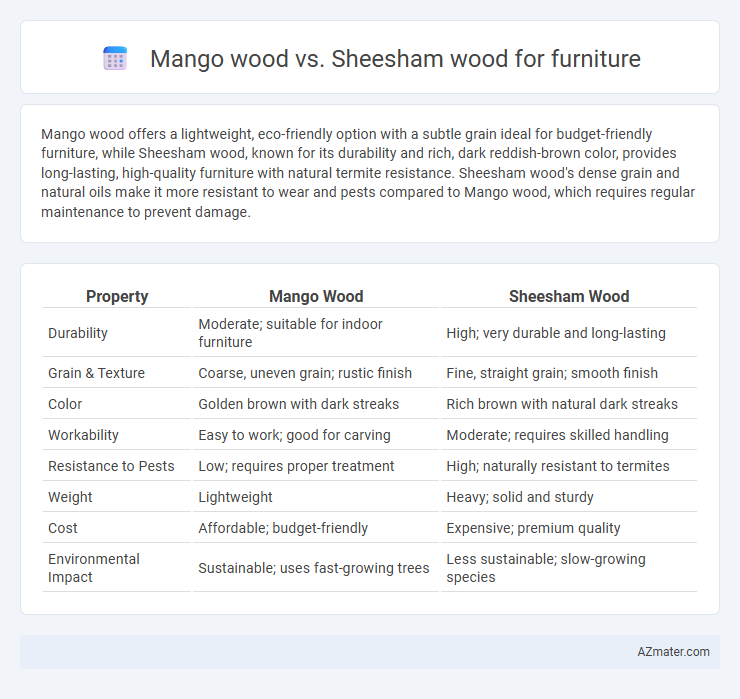Mango wood offers a lightweight, eco-friendly option with a subtle grain ideal for budget-friendly furniture, while Sheesham wood, known for its durability and rich, dark reddish-brown color, provides long-lasting, high-quality furniture with natural termite resistance. Sheesham wood's dense grain and natural oils make it more resistant to wear and pests compared to Mango wood, which requires regular maintenance to prevent damage.
Table of Comparison
| Property | Mango Wood | Sheesham Wood |
|---|---|---|
| Durability | Moderate; suitable for indoor furniture | High; very durable and long-lasting |
| Grain & Texture | Coarse, uneven grain; rustic finish | Fine, straight grain; smooth finish |
| Color | Golden brown with dark streaks | Rich brown with natural dark streaks |
| Workability | Easy to work; good for carving | Moderate; requires skilled handling |
| Resistance to Pests | Low; requires proper treatment | High; naturally resistant to termites |
| Weight | Lightweight | Heavy; solid and sturdy |
| Cost | Affordable; budget-friendly | Expensive; premium quality |
| Environmental Impact | Sustainable; uses fast-growing trees | Less sustainable; slow-growing species |
Introduction to Mango Wood and Sheesham Wood
Mango wood, derived from the fast-growing mango tree, is a sustainable and eco-friendly option known for its durability and attractive grain patterns, making it ideal for furniture crafting. Sheesham wood, also called Indian rosewood, is prized for its rich color, natural oils, and resistance to decay, offering a luxurious and long-lasting choice for high-quality furniture. Both woods provide unique aesthetic appeal and strength, with mango wood being more affordable and Sheesham favored for premium, intricate designs.
Botanical Origins and Geographic Distribution
Mango wood, derived from the Mangifera indica tree native to South Asia and widely cultivated in India, Bangladesh, and Myanmar, is valued for its sustainable growth and moderate density. Sheesham wood, sourced from Dalbergia sissoo, commonly known as Indian rosewood, is primarily found across the Indian subcontinent and parts of Southeast Asia, prized for its durability and rich, dark grain. Both woods reflect distinct botanical origins with mango trees belonging to the Anacardiaceae family and sheesham to the Fabaceae family, influencing their geographic distribution and wood characteristics.
Physical Appearance and Grain Patterns
Mango wood features a light yellow-brown color with occasional darker streaks, offering a smooth texture and straight grain that enhances furniture brightness. Sheesham wood displays a rich dark brown hue with intricate, wavy, and interlocked grain patterns, contributing to a more luxurious and textured appearance. The contrasting grain structures make mango wood suitable for a modern, clean look, while sheesham wood provides a classic, ornate appeal in furniture design.
Durability and Strength Comparison
Mango wood offers moderate durability and strength, making it suitable for lightweight furniture but less ideal for heavy-use items compared to Sheesham wood. Sheesham wood, known for its dense grain and natural oils, provides superior strength and resistance to wear, ensuring long-lasting furniture quality. The natural durability of Sheesham wood also makes it more resistant to termites and environmental damage than mango wood.
Workability and Crafting Ease
Mango wood offers superior workability for furniture making due to its relatively softer texture and consistent grain, allowing artisans to easily carve and shape intricate designs. Sheesham wood, known for its density and durability, requires more patience and specialized tools during crafting but rewards with a rich, natural finish and strength. Both woods provide distinct advantages, with mango wood favored for swift, detailed work and sheesham selected for robust, long-lasting pieces.
Sustainability and Environmental Impact
Mango wood is highly sustainable due to its rapid growth and harvesting from trees no longer producing fruit, minimizing deforestation risks. Sheesham wood, known for durability but slower growth, requires more extended cultivation periods, impacting environmental regeneration cycles. Choosing mango wood supports eco-friendly furniture production by utilizing an agricultural byproduct, while sheesham wood demands careful forest management to maintain ecological balance.
Cost and Market Price Differences
Mango wood furniture is generally more affordable than Sheesham wood, making it a popular choice for budget-conscious buyers. Sheesham wood, known for its durability and rich grain patterns, commands a higher market price due to its superior quality and limited availability. The cost difference reflects Sheesham's long-lasting nature and aesthetic appeal compared to the softer, more affordable mango wood.
Maintenance and Longevity
Mango wood requires regular oiling and polishing to maintain its appearance and prevent drying or cracking, offering moderate durability in furniture use. Sheesham wood, known for its natural oils and dense grain, resists pests and moisture better, resulting in longer-lasting furniture with less intensive upkeep. Both woods benefit from keeping away from excessive humidity, but Sheesham generally offers superior longevity and lower maintenance demands.
Common Uses in Furniture Design
Mango wood is widely used for crafting affordable, eco-friendly furniture pieces such as coffee tables, bookshelves, and bed frames due to its durability and smooth grain. Sheesham wood, also known as Indian rosewood, is favored for high-end furniture like carved wardrobes, dining sets, and ornate chests because of its rich color, density, and resistance to termites. Both woods offer distinct aesthetics and functional benefits, making them popular choices in diverse furniture designs.
Pros and Cons: Mango Wood vs. Sheesham Wood
Mango wood is lightweight, eco-friendly, and affordable, making it ideal for budget-conscious furniture, but it is less durable and prone to dents compared to Sheesham wood. Sheesham wood, known for its rich grain and natural oils, offers superior strength and resistance to termites, but it is heavier and more expensive than mango wood. Both woods vary in maintenance needs: mango wood requires regular sealing, while Sheesham wood demands polishing to maintain its glossy finish.

Infographic: Mango wood vs Sheesham wood for Furniture
 azmater.com
azmater.com